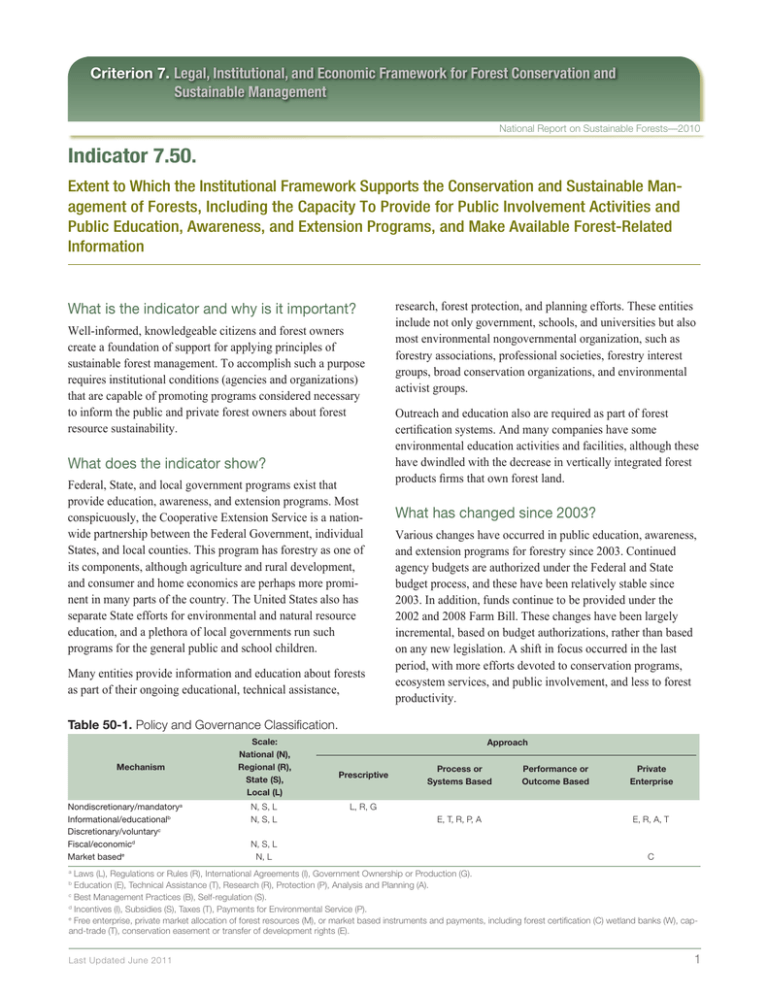Indicator 7.50.
advertisement

Criterion 7. Legal, Institutional, and Economic Framework for Forest Conservation and Sustainable Management National Report on Sustainable Forests—2010 Indicator 7.50. Extent to Which the Institutional Framework Supports the Conservation and Sustainable Management of Forests, Including the Capacity To Provide for Public Involvement Activities and Public Education, Awareness, and Extension Programs, and Make Available Forest-Related Information What is the indicator and why is it important? Well-informed, knowledgeable citizens and forest owners create a foundation of support for applying principles of sustainable forest management. To accomplish such a purpose requires institutional conditions (agencies and organizations) that are capable of promoting programs considered necessary to inform the public and private forest owners about forest resource sustainability. What does the indicator show? Federal, State, and local government programs exist that provide education, awareness, and extension programs. Most conspicuously, the Cooperative Extension Service is a nationwide partnership between the Federal Government, individual States, and local counties. This program has forestry as one of its components, although agriculture and rural development, and consumer and home economics are perhaps more prominent in many parts of the country. The United States also has separate State efforts for environmental and natural resource education, and a plethora of local governments run such programs for the general public and school children. Many entities provide information and education about forests as part of their ongoing educational, technical assistance, research, forest protection, and planning efforts. These entities include not only government, schools, and universities but also most environmental nongovernmental organization, such as forestry associations, professional societies, forestry interest groups, broad conservation organizations, and environmental activist groups. Outreach and education also are required as part of forest certification systems. And many companies have some environmental education activities and facilities, although these have dwindled with the decrease in vertically integrated forest products firms that own forest land. What has changed since 2003? Various changes have occurred in public education, awareness, and extension programs for forestry since 2003. Continued agency budgets are authorized under the Federal and State budget process, and these have been relatively stable since 2003. In addition, funds continue to be provided under the 2002 and 2008 Farm Bill. These changes have been largely incremental, based on budget authorizations, rather than based on any new legislation. A shift in focus occurred in the last period, with more efforts devoted to conservation programs, ecosystem services, and public involvement, and less to forest productivity. Table 50-1. Policy and Governance Classification. Mechanism Nondiscretionary/mandatorya Informational/educationalb Discretionary/voluntaryc Fiscal/economicd Market basede Scale: National (N), Regional (R), State (S), Local (L) N, S, L N, S, L N, S, L N, L Approach Prescriptive Process or Systems Based Performance or Outcome Based Private Enterprise L, R, G E, T, R, P, A E, R, A, T C Laws (L), Regulations or Rules (R), International Agreements (I), Government Ownership or Production (G). b Education (E), Technical Assistance (T), Research (R), Protection (P), Analysis and Planning (A). c Best Management Practices (B), Self-regulation (S). d Incentives (I), Subsidies (S), Taxes (T), Payments for Environmental Service (P). e Free enterprise, private market allocation of forest resources (M), or market based instruments and payments, including forest certification (C) wetland banks (W), capand-trade (T), conservation easement or transfer of development rights (E). a Last Updated June 2011 1



